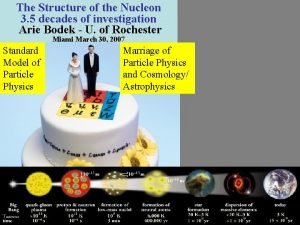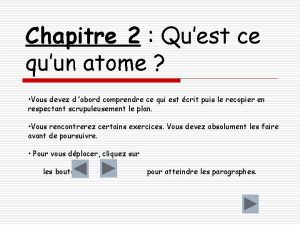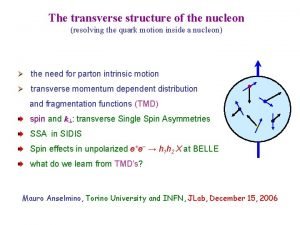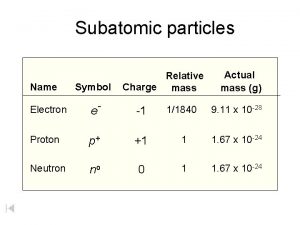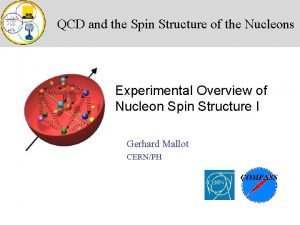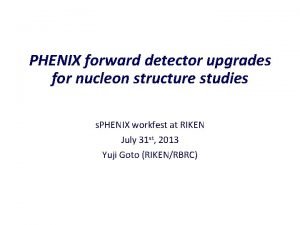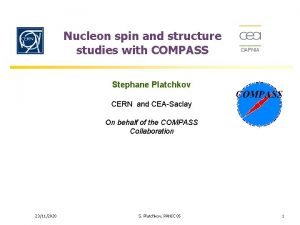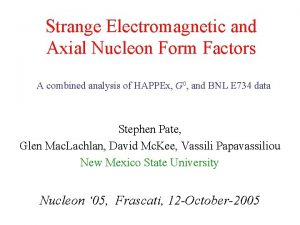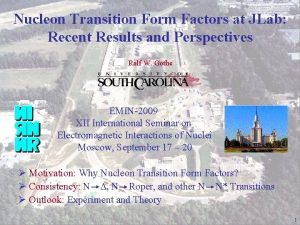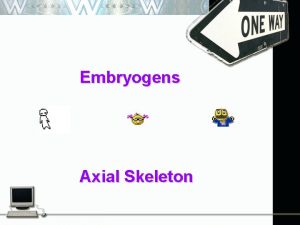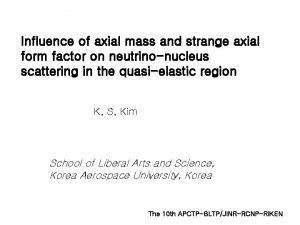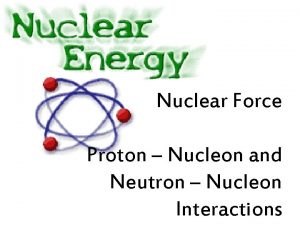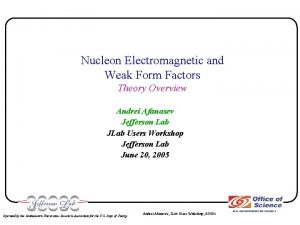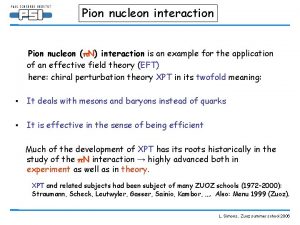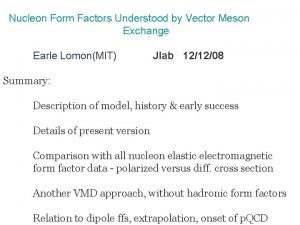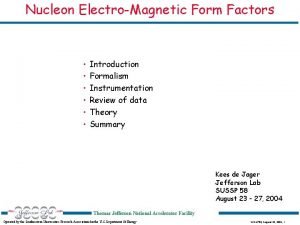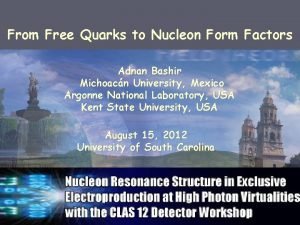Nucleon Axial and NucleontoDelta Axial Transition Form Factors
















- Slides: 16

Nucleon Axial and Nucleon-to-Delta Axial Transition Form Factors from Lattice QCD A. Tsapalis Institute of Accelerating Systems and Applications University of Athens in collaboration with C. Alexandrou (Univ. of Cyprus) G. Koutsou (Univ. of Cyprus) Th. Leontiou (Univ. of Cyprus) J. W. Negele (MIT)

outline • • • Nucleon Axial Form Factors GA and GP PCAC and pion pole dominance Nucleon-to-Delta Axial Transition FFs Lattice Evaluation of the FFs Results – Checking the Pion Pole dominance & Goldberger-Treiman (GT) relations in N-N & N-Δ • Conclusions ar. Xiv: 0706. 3011, to appear in PRD

Nucleon Axial Form Factors axial isovector current axial vector form factor induced pseudoscalar axial charge GA (0) = 1. 2695 (29) from nuclear β decay GA (q 2) – from neutrino scattering & pion electroproduction GP (q 2) – from muon capture experiments • theoretically studied in chiral effective theories • pioneering lattice study in PRL 74 2172 (1995) (K. F. Liu, S. J. Dong, T. Draper, W. Wilcox) • recent study by LHPC+MILC , ar. Xiv: 0705. 4295

Pseudoscalar Form Factor & PCAC in hadron world Axial WT identity in QCD pseudoscalar current πΝΝ form factor defined via connected to πΝΝ strong coupling constant gπΝΝ = GπΝΝ(mπ2) PCAC

Pion Pole dominance & GT relations Pion pole on RHS constraints the induced pseudoscalar and leads to Goldberger-Treiman relation at q 2 = 0 satisfy to 5% accuracy also fixes the ratio from low energy πΝΝ dynamics

Nucleon to Δ(1232) Axial Transition Form Factors Adler parameterization small ≈ 0 transverse part C 5 A analogous to GA (q 2) dominant FFs C 6 A analogous to GP (q 2) • not much known experimentally • electroproduction experiments at JLab will measure N to Δ parity violating asymmetry connected to C 5 A • theoretical arguments indicate that C 3 A, C 4 A are small

• Lattice study in PRL 98, 052003 (2006) established smallness of C 3 A and C 4 A , predicted q 2 dependence of dominant form factors C 5 A and C 6 A

Pseudoscalar πΝΔ Form Factor & PCAC πΝΔ form factor defined via connected to πΝΔ strong coupling constant gπΝΔ = GπΝΔ(mπ2) PCAC Non-diagonal Goldberger-Treiman relation Pion pole dominance relates: . . and fixes the ratio

Evaluating Form Factors from Lattice QCD • measure 3 -point-functions of axial & pseudoscalar currents X • form ratios where t- and Z- dependence cancels kinematics: • determine the optimal linear combination of 3 pts maximal number of momentum vectors contribute in rotationally symmetric fashion

optimizing the measurement • sequential inversions through the sink X • all operators and momenta measured at small cost • look for plateau in t 1 / Smear source & sink quarks to damp fast the excited states • only one sequential inversion for GA(Q 2), GP(Q 2), GπNN(Q 2) • simultaneous overconstrained analysis of all data maximal accuracy for the form factors – Q 2 dependence

Lattice parameters Wilson NF = 0 β=6. 0 323 x 64 a=0. 09 fm Nucleon Axial mπ = 0. 56 Ge. V mπ = 0. 49 Ge. V mπ = 0. 41 Ge. V Wilson NF = 2 β=5. 6 a=0. 08 fm 243 x 40 mπ = 0. 69 Ge. V (TXL) 243 x 40 mπ = 0. 51 Ge. V (TXL) 243 x 32 mπ = 0. 38 Ge. V (DESY) Hybrid scheme MILC NF = 2 + 1 N-to-Δ Axial + Domain Wall valence (L 5=16) a=0. 125 fm ams 0. 05 amu mπ 0. 03 0. 59 Ge. V 203 x 64 0. 02 0. 50 Ge. V 203 x 64 0. 01 0. 36 Ge. V 283 x 64

Checking the parameters Ground state dominance source-sink distance 11 a vs 13 a Volume (2. 5 fm)3 vs (3. 5 fm)3 plateaus for GπΝΝ GA(Q 2), GP(Q 2), GπNN(Q 2) C 5 A(Q 2), C 6 A(Q 2), GπNΔ(Q 2) Wilson MILC(DWF) Wilson NF=0, 323 x 64, mπ=0. 49 Ge. V NF=2, 243 x 40, mπ=0. 69 Ge. V NF=0, 323 x 64, mπ=0. 41 Ge. V 0. 01/0. 05, mπ=0. 36 Ge. V 203 x 64 vs 283 x 64,

Results (I) – Nucleon Axial Form Factors • dipole fit describes well GA m. A >=1. 5 Ge. V (solid / fit) m. A=1. 1 Ge. V (dotted / exp) • pion pole dominates Gp (dash) monopole fit (solid) Hybrid results from 0705. 4295 LHPC & MILC (Hägler etal)

Results (II) – N to Δ Axial Transition FFs • dipole fit describes well CA 5 m. A >=1. 5 Ge. V (solid / fit) m. A=1. 28 Ge. V (dotted / exp) • pion pole dominates CA 6 (dash: wilson) (dot: MILC) monopole fit (solid)

Results (III) – Checking Ratios of GT relations pion pole dominance renormalization constants, fπ , mq cancel 1. 63(1) 1. 60(2) 1. 73(3) weak Q 2 and mq dependence

Conclusions • momentum dependence of the NN & NΔ axial form factors is evaluated optimally in Lattice QCD • dipole dependence of GA and C 5 A is verified – requires larger axial mass at the 410 Me. V pion lattices • monopole behavior of Gp and C 6 A is verified • unquenching effects are visible at low Q 2 and mπ = 360 Me. V in the Hybrid scheme (MILC+DWF) – GA approaches expected behavior • ratios of GT relations in NN & NΔ systems are satisfied – show very weak quark mass and Q 2 dependence
 Nucleon
Nucleon M atome = a x m nucleon
M atome = a x m nucleon Nucleon
Nucleon Name of symbol
Name of symbol Nucleon
Nucleon Nucleon
Nucleon Nucleon
Nucleon Factors affecting glass transition temperature
Factors affecting glass transition temperature Biotic and abiotic environment
Biotic and abiotic environment Abiotic factors and biotic factors
Abiotic factors and biotic factors Abiotic factors and biotic factors
Abiotic factors and biotic factors Gcf of 8 and 6
Gcf of 8 and 6 Highest common factor
Highest common factor What are the factors of 8
What are the factors of 8 Affirmative form negative form interrogative form
Affirmative form negative form interrogative form Situation location
Situation location Biotic v abiotic
Biotic v abiotic
